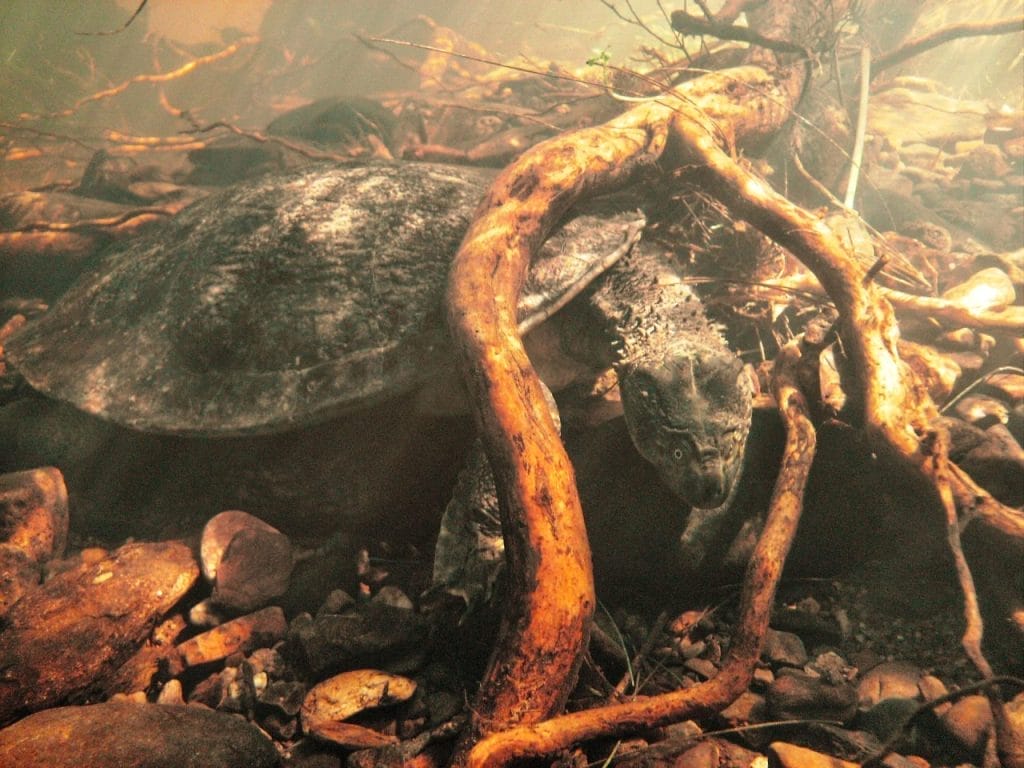Rheodytes leukops (Fitzroy River Turtle)
Home > Turtle Database > Rheodytes leukops (Fitzroy River Turtle)

Rheodytes leukops, commonly known as the Fitzroy River Turtle, is a unique freshwater species found only in Australia. It is best known for its ability to extract oxygen from water through cloacal respiration, allowing it to stay submerged for extended periods.
Native To These Regions
Queensland (Australia)Native Turtle Species Map – Find Turtles by Region
Scientific Classification
Kingdom: Animalia
Phylum: Chordata
Class: Reptilia
Order: Testudines
Family: Chelidae
Genus: Rheodytes
Species: Rheodytes leukops
Common Names
Fitzroy River Turtle
White-eyed River Turtle
This Hilarious Turtle Book Might Know Your Pet Better Than You Do
Let’s be real—most turtle care guides feel like reading a textbook written by a sleep-deprived zookeeper.
This one’s not that.
Told from the snarky point of view of a grumpy, judgmental turtle, 21 Turtle Truths You’ll Never Read in a Care Guide is packed with sarcasm, sass, and surprisingly useful insights.
And hey—you don’t have to commit to the whole thing just yet.
Grab 2 free truths from the ebook and get a taste of what your turtle really thinks about your setup, your food choices, and that weird plastic palm tree.
It’s funny, it’s honest, and if you’ve ever owned a turtle who glares at you like you’re the problem—you’ll feel seen.
Identification
Description
The Fitzroy River Turtle has a moderately flattened, oval-shaped shell that ranges from dark brown to olive-green. Its skin is grayish-brown with a distinctive pale ring around the eyes. Juveniles have serrated rear carapace edges that smooth out as they mature. The plastron is pale cream or yellowish.
Sexual Dimorphism
Females tend to be slightly larger than males, but males have longer, thicker tails. Males also have more concave plastrons, while females have flatter ones.
Native Origin and Distribution
Geographical Range
This species is endemic to Australia and is found exclusively in the Fitzroy River drainage system in Queensland.
Preferred Habitat
The Fitzroy River Turtle prefers fast-flowing, well-oxygenated freshwater rivers and streams with rocky or sandy substrates. It is typically found in deep pools and riffles where it can easily access high-oxygen water for cloacal respiration.
Behavior
Feeding Habits
It is primarily carnivorous, feeding on aquatic invertebrates, insects, mollusks, and crustaceans. It may also consume some plant material and algae.
Predators
Natural predators include birds of prey, large fish, and introduced species such as feral cats and foxes. Hatchlings are especially vulnerable to predation.
Reproduction
Breeding Season
Nesting occurs during the dry season, usually between late spring and early summer (October to January).
Reproductive Method
Females lay clutches of around 10–15 eggs in sandy riverbanks. Incubation lasts about 45–60 days, and hatchlings emerge during the rainy season when water levels rise.
Conservation
Extinction Status
Listed as Vulnerable by the IUCN Red List due to habitat degradation and other threats.
Threats
Major threats include water pollution, habitat destruction from damming and agriculture, predation by invasive species, and human disturbance. Changes in water flow due to human activities significantly impact their population.
Conservation Measures
Conservation efforts include habitat protection, monitoring programs, and public awareness campaigns to reduce human impact. Some areas have implemented predator control to protect eggs and hatchlings.
Economic Importance
The Fitzroy River Turtle plays a role in maintaining the aquatic ecosystem by controlling insect and mollusk populations. It is also of scientific interest due to its rare cloacal respiration ability.
Interesting Facts
This species can extract up to 70% of its oxygen needs through its cloaca, earning it the nickname “bum-breathing turtle.” Juveniles tend to be more active swimmers, while adults rely more on passive drifting in fast currents. The species was only formally described in 1980, making it one of the more recently discovered Australian turtles.

About Author
Muntaseer Rahman started keeping pet turtles back in 2013. He also owns the largest Turtle & Tortoise Facebook community in Bangladesh. These days he is mostly active on Facebook.











